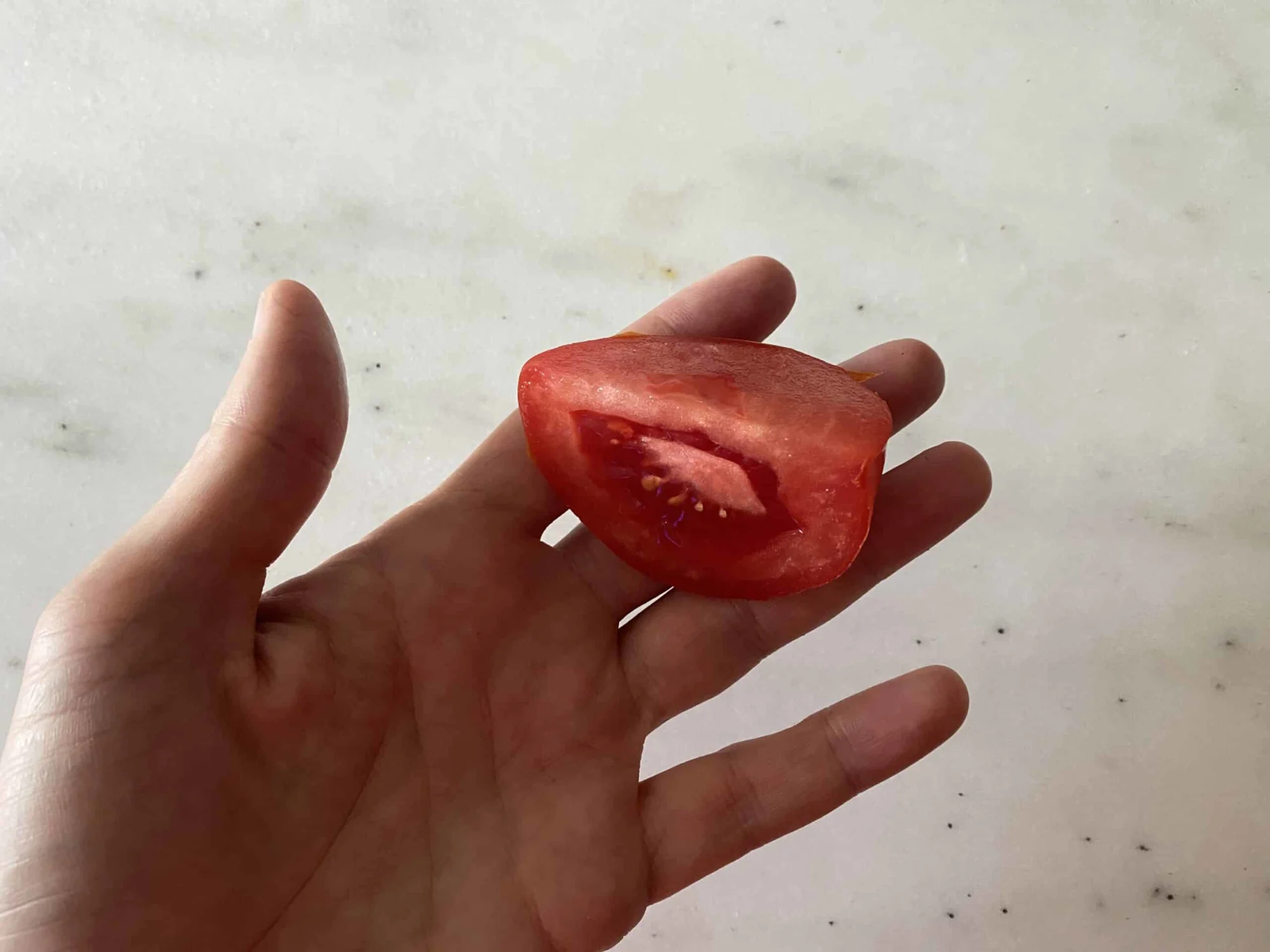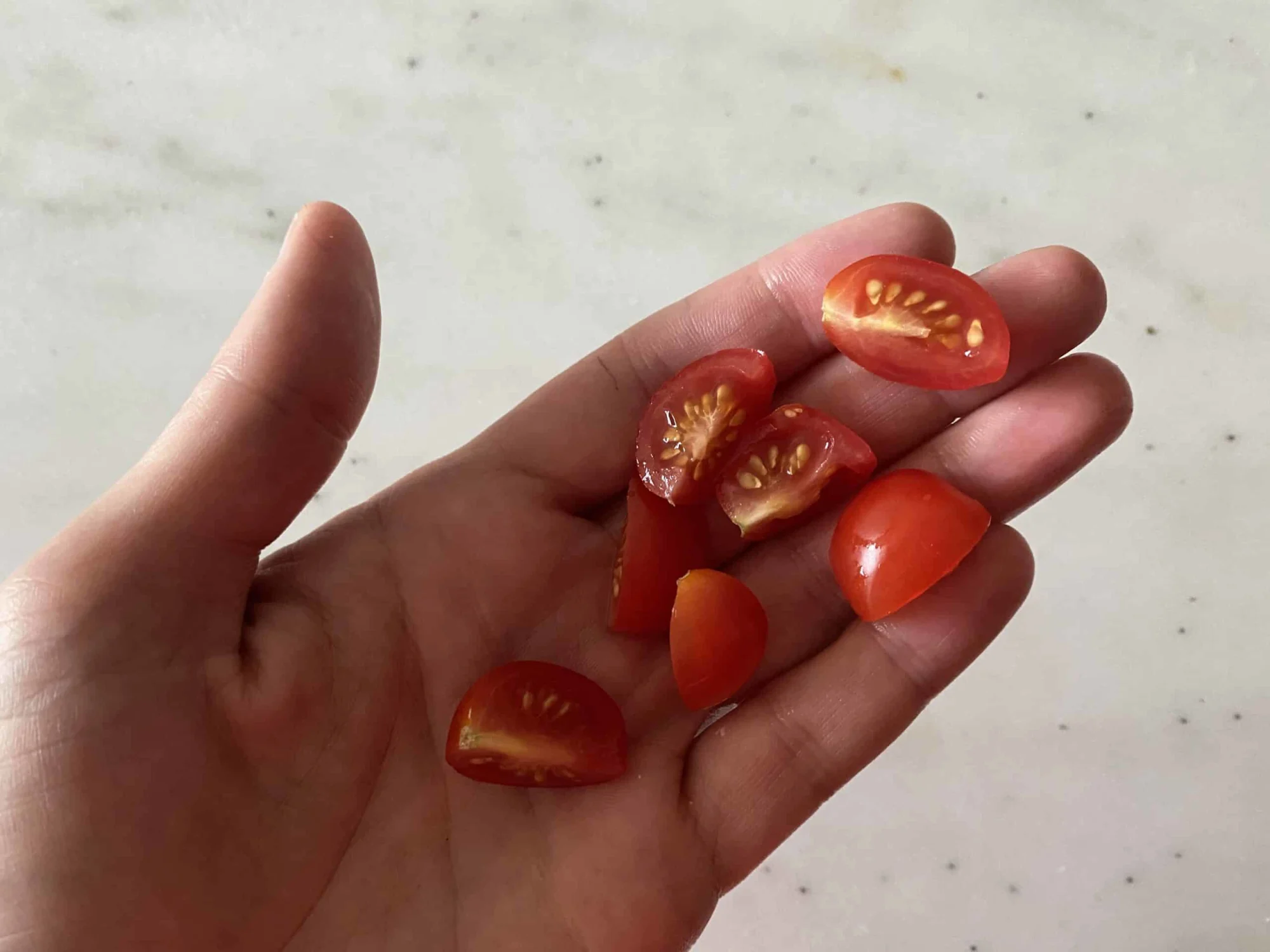Access our First Foods® Database in the Solid Starts App.
Learn moreTomato
Vegetable
Age Suggestion
6 months
Iron-Rich
No
Common Allergen
No

Warning
Tomatoes, especially grape and cherry tomatoes, are a common choking hazard, so keep reading to learn how to serve safely.
When can babies have tomato?
Tomatoes may be introduced as soon as baby is ready to start solids, which is generally around 6 months of age. Tomatoes and other acidic foods can cause a harmless rash on skin that comes into contact with the juices and sometimes can cause or worsen diaper rash.
The tomato plant is native to Central and South America, where it is believed to have been first cultivated by Aztecs, who gave the Nahuatl name of tomātl to the plump juicy fruit. While its roots are in the Americas, tomatoes are one of the most ubiquitous ingredients in cooking today in part due to the Spanish conquistadors, who took the seeds to Europe.
How do you serve tomato to babies?
Every baby develops on their own timeline, and the suggestions on how to cut or prepare particular foods are generalizations for a broad audience.
6 months old +:
Quarter a large tomato and offer the wedges for baby to suck and munch on. If the tomato skin becomes a nuisance, simply take it away and offer a fresh wedge. At this stage you can also offer a whole, large, ripe tomato for baby to eat, as if they were eating a whole peach. Keep in mind that a tomato contains multiple textures: slippery skin, soft flesh, small seeds, and juicy pulp, which may lead to gagging and coughing. Tomatoes can cause a rash where acidic juice comes into contact with a baby’s skin and can also contribute to diaper rash, so be mindful not to offer too much. If baby seems sensitive to the juices, try serving cooked tomato or another food in a simple tomato sauce.
9 months old +:
Try serving quartered cherry tomatoes as finger food or to practice with a pre-loaded fork. Keep an eye out for any lingering tomato skins, and if they come off while eating, coach baby to spit them out by sticking your tongue out. Alternatively, serve large, ripe wedges, or thin, round slices of tomato, or other foods in tomato sauce.
24 months old +:
You can continue to serve quartered cherry tomatoes. When you feel the child has developed mature eating skills (taking small bites with their teeth, moving food to the side of the mouth when chewing, chewing thoroughly before swallowing, not stuffing food in their mouths, and finally, identifying and spitting out foods when they are not well chewed) AND they are able to eat quartered cherry tomatoes with ease, they may be ready to learn how to eat whole cherry tomatoes. Remember that practice with whole cherry tomatoes should always be in a supported seat with direct supervision and coaching from you.
If you have not yet offered cherry tomatoes halved lengthwise, you may want to begin with this size before progressing to whole ones. Then, start with large, ripe cherry tomatoes—the larger the better. We recommend the long, oval-shaped ones (sometimes called grape tomatoes) instead of the smaller round size, as the larger ones are more likely to get the child to bite into them as opposed to placing the whole thing in their mouth. We recommend you demonstrate first: taking a slow bite to cut the tomato in half with your front teeth. Hand the other half to the toddler and let him or her take it and eat it. Then offer the second whole cherry tomato to the child and let him or her follow your lead with eating it. Likely, they will bite it in half as you did, though if the child shoves the whole thing in their mouth, refrain from gasping or yelling. Remain calm and say, “That’s a very big bite. You need to chew it.” Then wait patiently as they chew and swallow or spit out the food. From there, either end the activity and go back to smaller pieces for a while if the child seems to struggle or try a few times more with additional coaching to see if they can build on their skills.


Add some variety to mealtimes with our guide, 100 Dinners for Babies & Toddlers.
Videos
Are tomatoes a choking hazard for babies?
Yes, particularly cherry and grape tomatoes, which are small, round, and slippery, qualities that increase the risk of choking. To reduce the risk, prepare and serve tomatoes in an age-appropriate way. Keep in mind that a tomato contains multiple textures: slippery skin, soft flesh, small seeds, and juicy pulp, which may lead to gagging and coughing. As always, make sure you create a safe eating environment and stay within an arm’s reach of baby during meals.
Learn the signs of choking and gagging and more about choking first aid in our free guides, Infant Rescue and Toddler Rescue.
Is tomato a common allergen?
No. Tomato allergy is uncommon, but not unheard of. Tomatoes are part of the nightshade family of plants, and some individuals may be sensitive to the nightshade family, although information is limited. Additionally, individuals with Oral Allergy Syndrome (and in particular those allergic to grass or ragweed) may be sensitive to tomatoes, resulting in itching or discomfort in the mouth. Cooking the tomato can reduce the chance of experiencing oral allergy symptoms.
Note: Tomatoes and other acidic foods can cause a harmless rash on skin that comes into contact with the juices and sometimes contribute to diaper rash. The skin rash, which typically shows up around the mouth and chin is typically harmless and usually dissipates within minutes once the skin is gently cleansed.
As you would when introducing any new food, start by offering a small quantity on its own for the first few servings and watch closely as baby eats. If there is no adverse reaction, gradually increase the serving size over time.
Are tomatoes healthy for babies?
Yes. Tomatoes have tons of vitamin C, which makes them an ideal pairing with foods that are rich in plant-based iron, such as beans, lentils, and peas. (Vitamin C aids the absorption of iron from plant foods.) Tomatoes are also packed with carotenoids, a group of phytonutrients that color plants and provide antioxidant and anti-inflammatory benefits to our bodies. Phytonutrients differ by variety of tomato and each offers unique benefits from promoting eyesight, immunity, and heart health to protecting skin against the sun.
Does baby need a high chair?
While a high chair can help create a safe eating environment, there are alternative ways for baby to eat safely, such as holding the child on your lap or sitting together on the floor. For more information, see our article on high chairs.
How do I calm my own nerves around starting solids?
Knowledge and practice with rescue maneuvers. Parents and caregivers who watch the choking and rescue videos in our Starting Solids bundle often share how confident they feel.
Our Team
Written by
Expert Tips Delivered to Your Inbox
Sign up for weekly tips, recipes and more!
Copyright © 2025 • Solid Starts Inc










